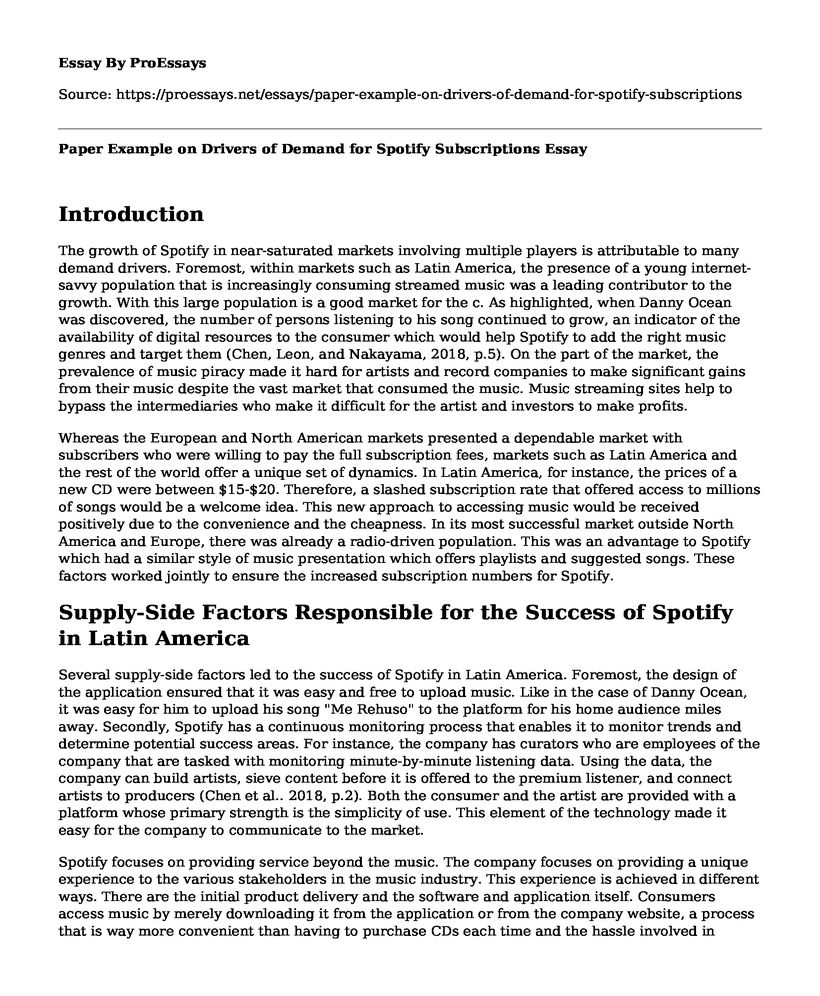Introduction
The growth of Spotify in near-saturated markets involving multiple players is attributable to many demand drivers. Foremost, within markets such as Latin America, the presence of a young internet-savvy population that is increasingly consuming streamed music was a leading contributor to the growth. With this large population is a good market for the c. As highlighted, when Danny Ocean was discovered, the number of persons listening to his song continued to grow, an indicator of the availability of digital resources to the consumer which would help Spotify to add the right music genres and target them (Chen, Leon, and Nakayama, 2018, p.5). On the part of the market, the prevalence of music piracy made it hard for artists and record companies to make significant gains from their music despite the vast market that consumed the music. Music streaming sites help to bypass the intermediaries who make it difficult for the artist and investors to make profits.
Whereas the European and North American markets presented a dependable market with subscribers who were willing to pay the full subscription fees, markets such as Latin America and the rest of the world offer a unique set of dynamics. In Latin America, for instance, the prices of a new CD were between $15-$20. Therefore, a slashed subscription rate that offered access to millions of songs would be a welcome idea. This new approach to accessing music would be received positively due to the convenience and the cheapness. In its most successful market outside North America and Europe, there was already a radio-driven population. This was an advantage to Spotify which had a similar style of music presentation which offers playlists and suggested songs. These factors worked jointly to ensure the increased subscription numbers for Spotify.
Supply-Side Factors Responsible for the Success of Spotify in Latin America
Several supply-side factors led to the success of Spotify in Latin America. Foremost, the design of the application ensured that it was easy and free to upload music. Like in the case of Danny Ocean, it was easy for him to upload his song "Me Rehuso" to the platform for his home audience miles away. Secondly, Spotify has a continuous monitoring process that enables it to monitor trends and determine potential success areas. For instance, the company has curators who are employees of the company that are tasked with monitoring minute-by-minute listening data. Using the data, the company can build artists, sieve content before it is offered to the premium listener, and connect artists to producers (Chen et al.. 2018, p.2). Both the consumer and the artist are provided with a platform whose primary strength is the simplicity of use. This element of the technology made it easy for the company to communicate to the market.
Spotify focuses on providing service beyond the music. The company focuses on providing a unique experience to the various stakeholders in the music industry. This experience is achieved in different ways. There are the initial product delivery and the software and application itself. Consumers access music by merely downloading it from the application or from the company website, a process that is way more convenient than having to purchase CDs each time and the hassle involved in acquiring them. The quality of the music is thus maintained at all time times every user enjoys the same experience. There is also the aspect of user interactivity whict handles the company to create a platform for continuous interactions which enhances and maintains subscription numbers.
Cross-Price Elasticity Explanation
Cross price elasticity of demand refers to the economic concept which measures how responsive the demand quantity of one product is affected by the price of a second product. It is calculated as a ratio of the percentage change in the demanded quantity of the first product to that of the second product (Nagle and Muller, 2017, p.17). The first product is the substitute good. So, this measure is always positive because when the price of one good increases, the demand for the substitute product increases. For example, an increase in the price of Apple musiMusicscriptions would lead to increased subscriptions on the Spotify platform as the consumer would be seeking the cheaper alternative. When the price of one product, Appl subscriptions, increases, the quantity demanded Spotify subscriptions increases as consumers switch to the less expensive but substitutable alternative that is Spotify. Mathematically, the cross-price elasticity demand is calculated as:
Ec = P1A+P2AQ1B+Q2BQBPA
Where:
P1A refers to the price of product A at an initial time.
P2A refers to the price of product A at a second time
Q1B refers to the quantity of product B demanded at an initial time
Q2B refers to the quantity of product B demanded at a second time
QB refers to the change in the quantity of the second product demanded
PA refers to the change in the price of the first product
Conclusion
Besides substitute products, there are also complimentary products, those that are associated with the first product. For such cases, the cross elasticity of demand is negative because as the price of the first product increases, that of the second product that is closely associated with it reduces since the demand for the main product reduces with an increase in its price.
Cite this page
Paper Example on Drivers of Demand for Spotify Subscriptions. (2022, Mar 16). Retrieved from https://proessays.net/essays/paper-example-on-drivers-of-demand-for-spotify-subscriptions
If you are the original author of this essay and no longer wish to have it published on the ProEssays website, please click below to request its removal:
- Should Minimum Wage Be Increased?
- Essay Example on Sleep Tight Inn: Equal Opportunity Employer at Risk
- Essay Example on Average CEO Salary at 6-Member Corporation: EPS 5
- Workplace Bullying of Temporary Employees: Prevalence and Causes - Essay Sample
- Labor Unions: Enhancing Employer-Employee Relationships - Report Sample
- Covid-19: HR Challenges in Business Productivity Amidst Job Losses - Essay Sample
- Free Paper - Fostering Success: Interplay of Organizational Structure and Culture in Workplaces







